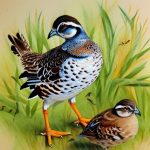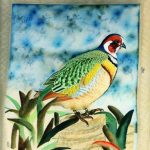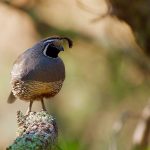The Mountain Quail (Oreortyx pictus) is a unique and beautiful bird species native to the western United States. They are known for their striking appearance, with a plump body, short tail, and distinctive chestnut and gray plumage. Mountain Quail are ground-dwelling birds that prefer dense brushy habitats in mountainous regions, hence their name. They are also known for their distinctive call, which is a series of loud, ringing notes that can be heard from a distance.
Mountain Quail are social birds that live in coveys, which are small family groups consisting of a mated pair and their offspring. They are primarily herbivorous, feeding on a variety of seeds, fruits, and insects. In the wild, Mountain Quail face threats from habitat loss, predation, and hunting, which has led to declines in their populations in some areas. As a result, there has been increasing interest in breeding Mountain Quail in captivity to help conserve the species and potentially reintroduce them to suitable habitats.
Table of Contents
Key Takeaways
- Mountain quail are a unique species of quail found in the western United States, known for their elusive nature and preference for high-altitude habitats.
- When selecting breeding stock for mountain quail, it is important to choose birds that are healthy, genetically diverse, and well-adapted to the local environment.
- Breeding enclosures and habitats for mountain quail should mimic their natural mountainous terrain, with plenty of cover, food sources, and protection from predators.
- Breeding techniques and practices for mountain quail should focus on providing a stress-free environment, proper nutrition, and monitoring for any signs of disease or distress.
- Incubation and hatching of mountain quail eggs require careful temperature and humidity control, as well as regular turning of the eggs to ensure proper development.
Selecting Breeding Stock
When selecting breeding stock for Mountain Quail, it is important to choose birds that are healthy, genetically diverse, and free from any hereditary diseases or defects. Breeding stock should be selected from unrelated individuals to avoid inbreeding and maintain genetic diversity within the captive population. It is also important to choose birds that exhibit natural behaviors and characteristics typical of the species, such as strong parental instincts and good foraging abilities.
In addition to physical and behavioral traits, breeding stock should also be selected based on their reproductive history. Birds that have successfully bred and raised offspring in the past are more likely to be successful breeders in captivity. It is also important to consider the age of the breeding stock, as younger birds may be more fertile and have a longer breeding lifespan. By carefully selecting breeding stock, breeders can help ensure the success of their breeding program and produce healthy offspring for conservation efforts.
Breeding Enclosures and Habitats
Creating suitable breeding enclosures and habitats for Mountain Quail is essential for successful breeding and rearing of offspring. Breeding enclosures should mimic the natural habitat of Mountain Quail, with dense brushy cover, open areas for foraging, and access to fresh water. The size of the breeding enclosures will depend on the number of birds being housed, but they should be spacious enough to allow for natural behaviors such as nesting, foraging, and social interactions.
In addition to providing suitable habitat within the breeding enclosures, it is important to consider the overall layout and design of the breeding facility. This may include providing sheltered areas for nesting, perches for roosting, and secure fencing to prevent escapes and protect birds from predators. Breeding enclosures should also be designed to allow for easy access for monitoring and maintenance, as well as providing a safe and comfortable environment for both the birds and the breeders.
Breeding Techniques and Practices
Breeding Mountain Quail in captivity requires careful management and attention to detail to ensure successful reproduction and healthy offspring. Breeding techniques may include natural mating within breeding enclosures or artificial insemination to facilitate breeding between specific individuals. It is important to monitor breeding pairs closely to ensure that mating is successful and that eggs are being laid and incubated properly.
In addition to monitoring breeding behavior, it is important to provide suitable nesting materials and conditions to encourage successful reproduction. This may include providing nesting boxes or shelters within the breeding enclosures, as well as ensuring that nesting materials such as grasses, leaves, and twigs are readily available. Breeders should also be prepared to intervene if necessary, such as providing supplemental heat or humidity for eggs or chicks if natural conditions are not sufficient.
Incubation and Hatching
Once eggs have been laid by breeding pairs, they will need to be carefully incubated to ensure successful hatching. Mountain Quail eggs typically have an incubation period of around 23-24 days, during which time they require consistent temperature and humidity levels. Breeders may choose to use artificial incubators or allow natural incubation by the breeding pairs, depending on their preferences and experience.
During incubation, it is important to monitor the eggs closely for signs of development and to make any necessary adjustments to temperature or humidity levels. Once the eggs begin to hatch, breeders should be prepared to provide assistance if needed, such as helping chicks out of their shells or providing supplemental warmth until they are able to regulate their own body temperature. Careful monitoring and intervention during incubation and hatching are essential for ensuring the health and survival of the chicks.
Care and Rearing of Chicks

After hatching, Mountain Quail chicks require careful care and attention to ensure their health and development. Chicks should be provided with a suitable brooder environment that includes warmth, access to food and water, and protection from drafts or predators. It is important to provide a balanced diet for the chicks that includes a variety of seeds, insects, and greens to support their growth and development.
In addition to providing for their physical needs, it is important to consider the social needs of the chicks as well. Chicks should be raised in groups to encourage natural social behaviors and reduce stress. Breeders should also provide opportunities for chicks to explore their environment and develop natural foraging skills. Careful observation and monitoring of the chicks will help ensure that they are healthy and developing normally.
Release and Management of Offspring
Once the chicks have reached an appropriate age and size, they may be considered for release into suitable habitats as part of conservation efforts. Before release, it is important to consider factors such as predator control, habitat suitability, and potential threats to released birds. Chicks should be given time to acclimate to their new environment before release, which may include providing a transitional enclosure or pen within the release area.
After release, it is important to monitor the released birds closely to assess their survival and integration into the wild population. This may include tracking individual birds using radio telemetry or other monitoring methods. Ongoing management of released offspring may also include habitat restoration efforts, predator control measures, and public education programs to promote awareness and support for Mountain Quail conservation.
In conclusion, breeding Mountain Quail in captivity requires careful planning, management, and attention to detail. By understanding the natural history of the species, selecting suitable breeding stock, providing appropriate habitats and enclosures, implementing effective breeding techniques, and ensuring proper care and management of offspring, breeders can contribute to the conservation of this unique and beautiful bird species. Through collaborative efforts and ongoing research, it is possible to help ensure the survival of Mountain Quail for future generations to enjoy.
If you’re interested in breeding mountain quail, you may also want to explore the topic of what vegetables quails eat. Understanding their dietary needs is crucial for their health and well-being. For more information on this, check out the article “What Vegetables Do Quails Eat?” on PoultryWizard.com. It provides valuable insights into the nutritional requirements of quails and can be beneficial for anyone looking to raise these beautiful birds.
FAQs
What is mountain quail breeding season?
The breeding season for mountain quail typically occurs from late April to early July.
How do mountain quail build their nests?
Mountain quail build their nests on the ground, often in dense vegetation or under shrubs. The nest is a shallow depression lined with grass, leaves, and feathers.
How many eggs do mountain quail lay?
Mountain quail typically lay 9-10 eggs in a single clutch.
How long does it take for mountain quail eggs to hatch?
Mountain quail eggs take approximately 23-24 days to hatch after being laid.
What is the role of the male mountain quail in the breeding process?
The male mountain quail plays a significant role in incubating the eggs, often sharing the responsibility with the female. Once the eggs hatch, both parents are involved in caring for the chicks.
Meet Walter, the feathered-friend fanatic of Florida! Nestled in the sunshine state, Walter struts through life with his feathered companions, clucking his way to happiness. With a coop that’s fancier than a five-star hotel, he’s the Don Juan of the chicken world. When he’s not teaching his hens to do the cha-cha, you’ll find him in a heated debate with his prized rooster, Sir Clucks-a-Lot. Walter’s poultry passion is no yolk; he’s the sunny-side-up guy you never knew you needed in your flock of friends!







